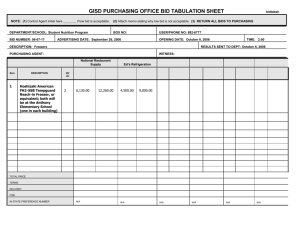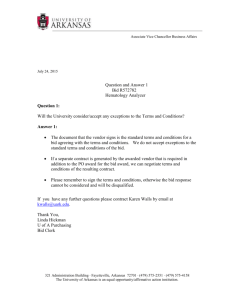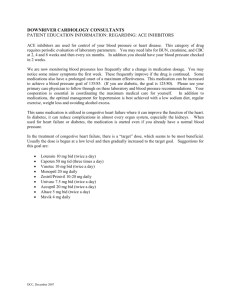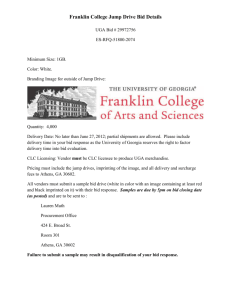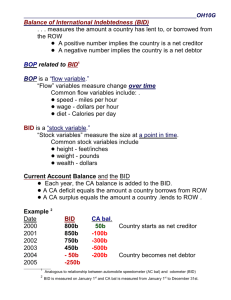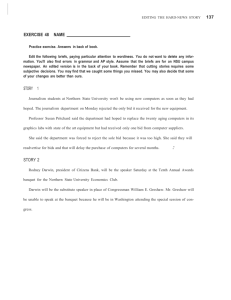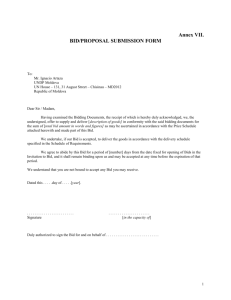- woodenhouse design & media
advertisement
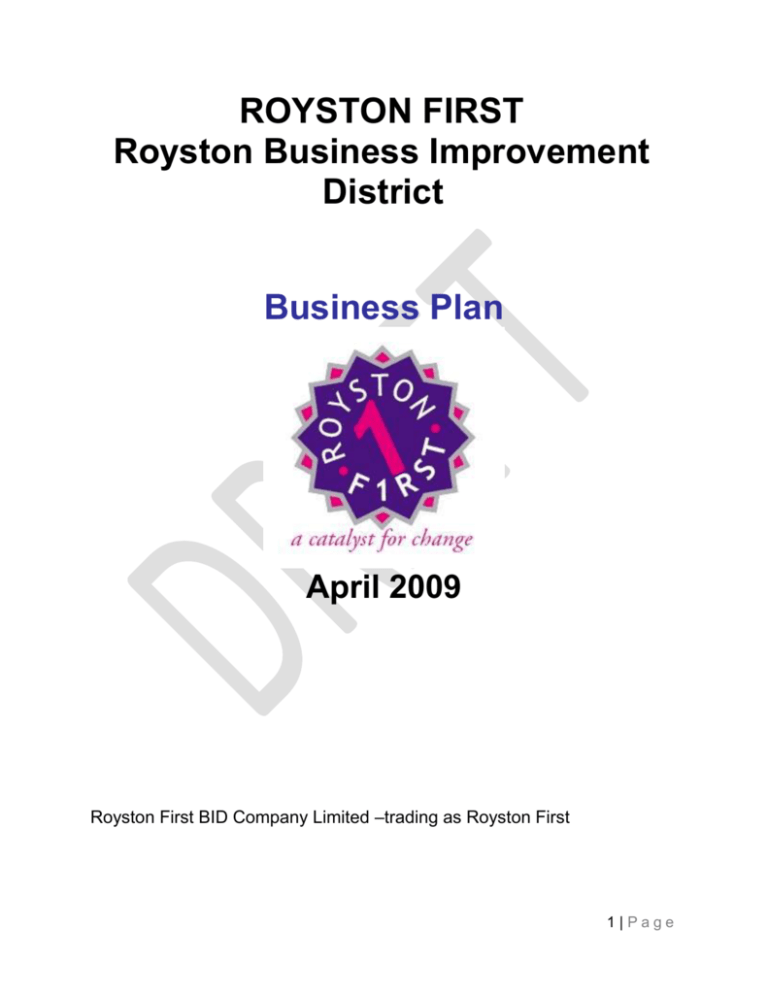
ROYSTON FIRST Royston Business Improvement District Business Plan April 2009 Royston First BID Company Limited –trading as Royston First 1|Page Contents: Foreword by the Chairman of Royston First 3 Why Royston? 4 What is A BID? 4 The benefits of a BID 4 Our goal 5 Strategic objectives 5 The BID planning, research and preparation 5 Royston First priorities 6 The projects 6-9 Income & Expenditure 10 & 11 The BID Area 12 & 13 Managing the BID 14 & 15 The BID financial arrangements 16 & 17 Measuring success 18 Key performance indicators 18 Core Services monitoring 18 The BID risk analysis 19 Concluding statement 19 2|Page Foreword by the Chairman of Royston First: John Gourd Site Director Johnson Matthey plc 3|Page Why Royston? Our town has experienced changing fortunes over the years. Reflecting a nationwide picture, our high street shops have reduced in number and variety in the face of competition from out of town traders and declining footfall. Some parts of town look tired and unloved; others lack cohesion and visibility. Under pressure from reduced budget allocations from central government, local authorities never seem to have the funding to introduce improvements. Conversely, we have significant commercial business trading successfully from Royston, including a number of companies prominent in the region and some of international renown. We also have many attractive buildings and lots of green space in and around the town. Clearly there are trends to be resisted and assets to be explored but inevitably pressure on existing resources and too little funding means we continually lose out to our bigger neighbours. The time has arrived to halt the decline and re-establish Royston as an attractive market town with lots to see and do. North Hertfordshire District Council (NHDC), Royston Town Council (RTC) and a few dedicated private sector sponsors have funded a Town Management programme since 2003. It provides a number of services, but it is obvious that more activity is needed to ensure that Royston maintains and improves its competitiveness. Royston First BID Company Ltd. (Royston First) will give businesses a unique opportunity to have a direct influence on the needs of the town and give it new life and energy over the next five years. The town’s strength lies in the diversity of its businesses, a solid foundation on which to re-build the town for future generations. What is a BID? A Business Improvement District is a partnership between a local authority and the local business community to develop projects and services that will benefit the trading environment within the boundary of a clearly defined commercial area. The BID is run by an independent, not-for-profit company running a programme of additional services over and above already provided by the public. For Royston, this uniquely includes the all the business areas in the town – industrial, commercial and retail. The benefits of a BID A BID is one step on from the existing Town Management process. It has guaranteed income over a fixed period to invest in activities purely designed to enhance Royston. There is no “freeloading. With a BID, everyone pays in proportion to the size of their company. The BID will operate over five years. The income available to the BID company is known and can be allocated to short, medium and long-term projects. It is hoped that the fixed income will be supplemented by public sector grants, earned income and sponsorship. NHDC and RTC have both agreed to sustain their town centre funding – which will result in less BID funding being allocated to overheads. 4|Page Our goal: Royston First will drive through a series of business-led initiatives that significantly improve the attraction of Royston to local people, investors, workers and visitors, thereby raising the profitability of businesses participating in the BID while, at the same time making it a better, brighter place to live. Strategic objectives: By working closely with our partners from North Hertfordshire District Council, Royston Town Council, the Town Centre Forum, the Chamber of Commerce and Hertfordshire Police, we seek to: • Improve community facilities and social cohesion • Improve the perception of safety and attractiveness of the town • Increase and promote local businesses and the standards they trade by • Increase the involvement of businesses in the local community • Liaise with other organisations that are dedicated to raising the profile and appeal of Royston • Better manage the health and well-being of the economy of the whole town The BID research, planning and preparation: The projects outlined in this Business Plan have been identified by listening to business concerns, ideas and priorities. In addition, opinions were sampled from workers, residents and shoppers and those who should visit Royston but currently don’t. In-depth research was conducted by an independent consultancy, New Horizon Ltd., which conducted street surveys and telephone research. The BID planning team also sought the opinions of all businesses throughout the town and the industrial park via a detailed questionnaire. Interactive briefing sessions have been held where potential levy payers were invited to view a range of projects. A selection from those nominated were circulated and businesses were invited to prioritise the list. The results of this exercise were used to fine-tune this Business Plan. Core Service Monitoring arrangements will be put place for NHDC and Hertfordshire Police to guarantee the sustaining of existing service levels. This will ensure that the new services and projects will bring benefits additional to those already provided. These services will be monitored and effective and efficient working practices encouraged throughout the life of the BID. 5|Page Royston First priorities: The conclusions of the research condense into four groupings: • Projects making Royston a better place to live (Community) • Initiatives to create a better-looking and performing town (Vitality) • Measures to improve security of people and premises (Security) • Ideas to increase awareness of what Royston has to offer (Visibility) Listed in order of priority, Community-based projects will clearly need to feature as Royston First launches into the process of improvement. Vitality will also start to be tackled early-on through the enhancement of existing assets (whilst at the same time other projects will make Royston easier and more convenient to use). Safety issues will be addressed by a variety of means (police patrols, CCTV, ANPR, etc.) appropriate to the requirements of differing locations. Finally, the message of Royston First’s successes as they emerge will be communicated throughout the town and its hinterland. The Projects: Community: • Projects to be funded to enhance current youth provision There is little for teenagers in Royston to do compared with what they see available elsewhere. With no obvious social or entertainment activities, it is easy to understand the tendency to engage in mischief and petty vandalism. We intend to introduce projects that will help combat anti-social behaviour and offer a sense of place that “re-attaches” minors to the rest of the population. We have allocated £9K each year towards these projects but will seek further grant aid to increase the overall spend and hence the overall impact • Introduce Community Cinema to Royston Consistently appearing top in the answers to the “what would improve Royston” question in our surveys was the request for a local cinema. We know other small towns have tackled this problem successfully and already we have investigated what form the solution should take here and looked at suitable sites. Over the life of the BID we have set aside £115K to deliver a smallscale cinema that will show relatively recent releases at reasonable prices. Ultimately it may be possible that this item could become an income-generator for the BID but initially match-funding will be sought to help pay for the project • Encourage and support new and more sustainable events such as a Food Fayre Royston has significant housing close to the town centre and ample green space in which to run communal events such as carnivals, fetes, exhibitions and competitions. Greater engagement between the commercial areas of the town and the population will build a sense of ownership and discourage locals from seeking out such events in competitor destinations. We have earmarked £2k as seed funding in each of the first three years, with a bigger event at £5K in Year Four and culminating in a much grander community event costing £20K in Year 5 6|Page Vitality: • Introduce a better ‘look and feel’ to Angel Pavement Our research indicates that shopping remains one of the fundamental reasons why people come into the town centre. However their comments confirm that core shopping area is looking tired. Angel Pavement is in private ownership but we want to work with the landlords to raise the quality of this important town centre asset. We have reserved some funding (£18K) to pay for cosmetic improvements early in the life of the BID • Control pigeons Whilst in the process of improving the look and feel of various parts of Royston, we will also seek to persuade some of our messier wildlife neighbours to move to pastures new! We propose to spend £2K each year in making some areas less desirable to roosting pigeons • Test the potential for a retail revival by attracting a quality retailer into Royston Empty retail units are a nationwide concern. There is a universal decline in the numbers of smaller, independent businesses, especially those selling food, commodity and convenience merchandise. We want to start a campaign to repopulate vacant premises by running a pilot project to extend quality retailing in the town. Once we have a track record of cloning a successful business from one place to another, we will try and repeat the process as often as possible. We have allowed £10K for this task in each of years One and Five • Buy back parking in the town centre to offer as one-hour free spaces A key issue for town centre businesses is the perceived lack of short-stay, convenience parking. The general opinion is that would-be shoppers are dissuaded from venturing into the area and turn to the free car parking associated with major, out of town traders. We plan to “buy back” spaces to create free parking in the heart of the town. Sensitively policed to avoid abuse, this should increase usage appreciably and so benefit customers and traders alike. £15K is the annual provision for this important initiative • Establish an empty shops policy to deliver an improved appearance Given the economic outlook, the number of vacant units in the town is likely to increase during 2009. Whilst there have been recent successes in attracting new traders, some premises will inevitably remain on the market. We plan to set aside £5K a year to improve the appearance of empty shops to prevent them from detracting from the shopping experience. We will be seeking the cooperation of landlords to assist us with dressing empty windows • Run a shuttle bus between the industrial estate and the town centre at lunchtime We know there are hundreds of people working on the industrial estate and who could use a quick and easy way to access services (banks, post office, dry cleaners, sandwich shops, etc.) in the town centre at lunchtime. Our intention is to run a lunchtime shuttle bus service as an experiment in the summer of 2009, circling the Industrial estate and then heading into the heart of the town centre. We will fund costs to the tune of £10K in the first year, £8K in Year Two and a £5K subsidy in Year Three (we assume break-even thereafter) 7|Page Security: • Purchase an additional two-person uniformed police foot patrol for late night duties in the town centre and around the industrial estate Another key priority is to extend the security cover we have throughout Royston. The single largest expenditure in our Year One budget (£50K) is dedicated to making a significant impact through late night police patrols. The objective is to combat anti-social behaviour around closing times and theft and vandalism carried out at night • Purchase mobile CCTV cameras and construct power columns for effective deployment Mobile G3 CCTV cameras can be moved into hotspot trouble areas within a matter of hours, assuming power columns are available. Their very appearance is frequently enough to reduce problem behaviour. Royston First proposes spending £15K on buying a new camera for dedicated use in Royston and expanding the number of columns where coverage can be provided. It is proposed that initially the new camera will be dedicated for use in the industrial estate to establish the most effective pattern of coverage prior to introduction of Automatic Number Plate Recognition (ANPR) technology in Year Four • Install Automatic Number Plate Recognition (ANPR) systems at both entrances to the industrial estate to record details of drivers and number plates One of the problems with having a successful industrial estate is that it becomes a target for thieves. Highly visible, ANPR systems and dedicated G3 cameras will bring the security provision on the industrial park in line with the best in the country. £72K spent over Years Four and Five will allow us to introduce and maintain cutting edge technology 8|Page Visibility: • Upgrade signage leading to and within the industrial estates Visitors to the main Industrial Estate experience difficulties locating the right premises and large vehicles frequently attempt difficult manoeuvres as a result. We will map the area in detail and then create signage at both entrance points that facilitates the whole process (taking into account planned traffic flows, possible turning areas, etc.) Also, at least two other industrial areas in the town require signposting. We have estimated signage will cost £20K as an initial “one-off” in Year Two. We will subsequently update information as it changes • Assist retailing with shopping guides, advertising, promotion and e-commerce Once Royston has started to look and feel better, more people need to come and enjoy its unique offer and setting. An attempt will be made to reach out via the internet and the introduction of centralised e-commerce. This activity will commence in Year Two with a spend of £12K with a further £9K over years Three to Five. Additional grants and sponsorship will also be sought. • Create ‘Gateways’ to either specific areas or the entire town highlighting features Royston has a lot to offer but much of it is hidden, especially from the huge volume of traffic that skirts the town every day. We wish to badge the town and promote our rich diversity by installing gateway signage on the major routes to the town (possibly on the approach roundabouts. We have allocated £14K to spread across the five main entrances into Royston. We expect to initiate this project during Year Five, once we have new attractions to feature • Introduce a tourism function for the town and heath, boosting the visibility and visitor experience of the Royston Cave in the process Tourism is an unknown quantity in Royston but given the proximity of Cambridge and RAF Duxford, we feel it could become important development area for us. It’s all a question of “setting out our stall” properly. £10K has been identified in Year Three to start actively publicising Royston to its hinterland and beyond, with a second £10K tranche of promotion scheduled for Year Five 9|Page Income and Expenditure: Income: The steering group has costed the BID operation (summarised in tables on page 11) and deemed that a levy of 2% of the rateable value of all hereditaments above the value of £2,500, with smaller businesses paying a flat rate £50 per annum. The precise details of arrangements follow under “Levy arrangements and collection” on page 15. The funds collected through the BID levy (currently estimated at £180,000 p.a.) will be kept in a separate BID bank account, held by the BID Company. The income from the levy, and from extra funds attracted, will be managed by the BID Board and used to fund local activities and services. Thus all the money is kept locally and spent locally, for the benefit of Royston. Once the BID is operational, income and expenditure will be reported monthly to the Board. Any changes in activity and spend will be agreed at Board level. Significant variation will require a further mandate from the entire electorate. Again, rules governing funding allocation are covered under Managing the BID (page 13) and Governance (page 16) The Board will agree on an annual basis how funds for subsequent years will be allocated. This will be based on business feedback during the previous year and agreed priorities for the coming year, which permit some flexibility to respond to varying business requirements and the state of the external market. Funding for Town Management from NHDC at current levels (£13,750 per annum) has been agreed for the first three years of the BID – with the expectation of continuance for years four and five. RTC have agreed to continue their current levels of Town Management grant (£10,000 per annum) for the five years of the BID – although Town Council budgets have to be allocated on an annual basis. Therefore, local authority funding of £23,750 is anticipated for the first year of the BID – with both councils also contributing via the BID levy. The BID levy should also make it easier to obtain other sources of “match-funded” public funding for specific projects and we will, at last, have the resources to pursue these opportunities. Expenditure: The activity list earlier has been priced up using information available to us at this time. Adjustments will be made to match true costs with actual revenues. A key principle of spending only the money available without taking on loans will be strictly adhered to. The BID will have some overheads such as the management of the company and servicing the BID membership. How this will be done is explained in the following paragraphs entitled “The Management of the BID”. Royston First has been able to budget just 22% by continuing funding and practices established by the Royston Town Centre Forum (average for other BIDs = £27K+). 10 | P a g e Projected BID Income and Expenditure over the five years: Estimated BID Income per year: Levy receipts Earned income Total Year One Year Two* Year Four £180,000 Year Five Total £180,000 Year Three £180,000 £180,000 £180,000 £ 900,000 £1,000 £2,000 £4,000 £5,000 £6,000 £18,000 £181,000 £182,000 £184,00 £185,000 £186,000 £918,000 Estimated BID Expenditure: BID projects Allocated spend currently 2011/12 2012/13 2013/14 2009/10 2010/11 £14,000 £36,000 £76,000 £24,000 £42,000 £60,000 £30,000 £27,000 £22,000 £42,000 £65,000 £42,500 £22,500 £89,500 £27,500 £0 £32,000 £15,000 £5,000 £29,000 Management £40,000 £40,000 £40,000 £40,000 £40,000 Annual total £179,000 £180,500 £180,500 £180,500 £180,500 Community Five-year total Vitality Security Visibility £901,000 11 | P a g e The Royston First Area: The proposed BID area covers all the streets in Royston including but not limited to: Abbots Yard Ackroyd Road Aintree Road Angel Pavement Ascot Road Ash Way Baldock Road (part) Baldock Street Barkway Road Barkway Street Barnack Grove Beldam Avenue Betjeman Road Betony Vale Beverley Close Blake Close Brampton Road Briary Lane Brooke Road Burns Road Butchers Walk Byron Road Campion Way Cartwright Road Cedar Crescent Charding Crescent Chaucer Road Cherry Drive Chestnut Walk Chilcourt Church Lane Clark Road Clydesdale Road Coltsfoot Drive Coombelands Copperfields Coronation Avenue Corvus Close Cowslip Close Curlew Crescent Dacre Green Days Close Dog Kennel Lane Donne Close Downlands Downsway Court Earls Hill Gardens Eastfield Road Echo Hill Eliot Road Elm Walk Ermine Close Farrier Court Field Crescent Fieldfare Way Fish Hill Fordham Road Foxglove Bank Furze Grove Gage Close Garden Close Garden Lane Garden Walk George Lane Goodwood Road Gower Road Granary Way Grange Bottom Grantham Close Grays Close Green Drift Green Lane Green Street Green Walk Greenfield Gresley Lodge Hampden Rise Hardy Drive Hargreaves Road Hawthorn Road Haydock Road Haywards Lane Heath Avenue Heathfield High Street Highlands Hillside Hollies Close Honey Way Housman Avenue Hunters Way Icknield Walk Isherwood Close Jarman Way Jeffrey Close Jepps Lane John Street Keats Close Kestrel Way Kiln House Yard King James Way King Street Kings Walk Kingston Vale Kingsway Kipling Road Kneesworth Street Lankester Road Larkin Drive Layston Park Leete Place Lime Grove Limekiln Close Limekiln Hill Lindsay Close Lingfield Road London Road Long Barrows Lower Gower Road Lower King Street Lumen Road Mackeral Hall Major Haddock Close Mallard Road Mallow Walk Maltings Close Maple Way Market Hill Market Place Martingale Road Masefield Way Melbourn Road Melbourn Street Middle Drift Mill Hill Mill Road Milton Close Minster Road Mortimer Road Morton Street Mounteagle Nash Road Newark Close Newbolt Newman Avenue Newmarket Road Nightingale Way Normans Lane North Close Old North Road Orchard Road Orchard Way Owen Drive Palace Gardens Parklands Parthia Close Perry Drive Phillips Avenue Phillips Court Pightle Close Pipit Close Pippin Grove Poplar Drive Primrose View Prince Andrews Close Princes Mews Priory Close Priory Lane Quail Walk Queens Road Queens Way Redwing Rise Ridgeway Rivermill Court Roan Walk Rochester Way Rock Road Rose Walk Rossetti Lodge Royse Grove Saddlers Place Saffron Street St. Marys Park Scott Close Serby Avenue Shaftesbury Way Shakespeare Shelley Close Shepherd Close Shrubbery Grove Siskin Close Skylark Place Sorrel Close South Close Spenser Close Stakepiece Road Stamford Avenue Stamford Close Station Yard Stephenson Close Stile Plantation Stuart Drive Studlands Rise Suffolk Road Sun Hill Swift Close Swinburne Close Tall Trees Tannery Close Tannery Drift Teasdale Close Teasel Close Tennyson Close Thackery Close The Beeches The Close The Dell The Drift Way The Fleet The Green The Lanterns The Quadrant The Shires The Warren Thomas Way Thurnall Avenue Towne Road Turpins Ride Upper King Street Upper Warren Valley Rise Victoria Crescent Victory Court Walnut Close Weston Avenue Wheatfield Crescent Whydale Road Willowside Way Windsor Road Woodcock Road Woodlands Woolsgrove Court Wordsworth Close Wartham Road Wrexham Terrace Yeats Close York Road York Way 12 | P a g e Multimap.com © Crown Copyright 2003. Under licence agreement 0100031673 reserved © eMapSite.com Ltd. All rights This is the official Royston BID boundary map. All eligible businesses in the streets inside this boundary will be subject to the terms and conditions of the proposed BID and they will vote and pay the BID levy at the prevailing rate at the start of each calendar year. 13 | P a g e Managing the BID: The fundamental proposition behind Royston First has been derived from close ties with the national BIDs movement in the UK following the creation of primary legislation (Statutory Instrument 2443 Local Government Act 2004). Grown from a local partnership that developed and delivered Town Centre Management (TCM), the current Manager brought together a team of experienced individuals who represent the key dimensions of Royston. This BID Steering Group is led by a key private sector director and supported by competent and experienced local business people and an external consultant. This team has been heavily involved in the communication of the facts and figures about the BID to all identified premises, the ongoing consultation process and the preparation of the final Business Plan and Prospectus. Moving forward from April 2009, the management and operation of the Royston First will be undertaken by the existing Town Manager and his support staff through the auspices of the Royston First BID Company Limited, a not-for-profit company limited by guarante. This will mean that the legal and financial liabilities of the BID company are covered and that the BID company will operate in a transparent way and be answerable to the businesses in the BID area. Royston First will be empowered by a formal “Operating Agreement” issued by the rating authority, North Hertfordshire District Council, prior to commencement of services. The Operating Agreement is a detailed set of protocols that covers the management of the BID as well as billing, collection and transfer of the BID levy. The BID Board will be responsible for the strategic management of the BID and be responsible for all decisions relating to the BID. The Board structure will be representative of the types of business and stakeholders in the BID area, and will also include representation from the local authority. The Chair will be appointed from the business members of the Board. Others may be co-opted onto the Board at its discretion. The BID company will formally report results of the annual audit and hold elections at its AGM. As well as this formal presentation, the performance of the company will be announced through ebulletins, a twice-yearly newsletter and regular briefings. Minor budget and project variations will be managed by staff and reported to the BID Board. Major variations will always be referred to the BID Board for approval except for substantive deviations, which will have to be put to a vote of all levypayers. Funding may be transferred between projects (due to projects being amended or postponed) as the needs of the business dictate on the authority and instruction of the BID Board, without resorting to an alteration ballot. As the BID is largely an investment by local businesses in the management of the trading environment, control will remain with those who are paying for the services. Consequently the Board members will be nominated by and be directly accountable to the contributing businesses. It will have a private sector chairperson and aims to consist of 17 members (as a maximum) including 13 elected Board members representing the different sectors of the levy payers in the BID area: Major industrial site businesses 2 Independent industrial site operators 2 Major, national retailers 2 Independent retail businesses 2 Pub and club operators 1 Property 1 Cafés and takeaways Financial and legal services Community representatives Hoteliers and Restaurants Council 1 Police 1 1 1 2 1 14 | P a g e The Board will meet at least quarterly. There will be four working groups established; each led by a different Board director, with one for each major project area (Community, Vitality, Visibility and Security). These teams will review project progress, expenditure and success, feeding their findings into the quarterly Board meetings. In the first year of operation, the Board will include the members of the Royston BID Steering Group under its current independent chairmen. In subsequent years, all members will be determined by ballot of the voters with a third of the elected Board retiring each year by rotation (unless no successor candidates have presented themselves). A stakeholders’ report will be issued every six months to inform on progress and there will be regular email bulletins sent out with the latest BID news. The website will continuously stream information both to stakeholders and the town. The accounts for the company and delivery against this Business Plan will be regularly assessed by external auditors to ensure maximum return on investment. They will be audited independently on an annual basis and be presented at the AGM - to which all levy payers will be invited. At the AGM levy, payers will also receive reports on the BID performance during the year and can question the Board on the progress of the BID and the town, before new Board members are elected. Royston First will operate for a five-year period, beginning 1st April 2009 and ceasing on the 31st March 2014, unless a re-ballot has taken place in the preceding three months to generate a mandate to continue for a further specified term. 15 | P a g e The BID financial arrangements: The Levy Arrangements: The BID investment levy will be the principal source of income for the BID. Royston First will apply a levy of 2p in the £ on all rateable properties with a rateable value of over £2,500 located in the eligible area. Those properties with a rateable value of £2,500 or less will pay a fixed contribution of £50 per year to be part of the BID organisation. The BID levy can be increased each year in line with the Retail Price Index, which can be viewed by accessing: www.statistics.gov.uk/CCI/nugget.asp?ID=19 The levy will be applied on the basis of year 2005 rateable values as at the 1st March 2009. If after 1st April 2009 the 2005-based rateable values change retrospectively because of an appeal, new and existing rateable properties will be subject to a levy based on the revised rateable value. A small sum of money will be set aside to meet any potential overpayment due to ratings appeals. Charitable status or mandatory charitable relief will not apply to the BID levy. The levy will also apply to offices, government buildings, doctors’ surgeries and other community related buildings. The BID levy will be chargeable to the registered ratepayer. However, the levy will be passed to the property owner whenever a rateable property is vacant. Businesses that begin to occupy existing rateable properties during the five year term of the BID will be liable to pay the levy annually provided the rateable property remains eligible for BID membership. New builds within the BID area will be subject to the levy. On change of ownership/ occupancy, the new occupier will be liable/invoiced but there will be no refunds of any levy paid to date. Similar arrangements are proposed for proprietors who sell property or terminate leases. Businesses in receivership and administration will be exempt, effectively from the date of sequestration/ liquidation. A significant revaluation of commercial properties is due in 2010. This will lead to changes in the Rateable Value of all hereditaments. The BID levy of 2% will be applied to new Rateable Values. Appeals against the new rateable values are expected throughout the 5 year rating period and can be retrospective. Consequently, monies received in Year Two which are in excess of Year One receipts will be held in a reserve account. At the end of Year Two, fifty percent of any additional receipts not repaid will be allocated to BID funds (the remainder will continue to be held in a reserve fund). Similar procedures are expected be followed in Years Three, Four and Five. 16 | P a g e Collection of the Levy: NHDC have generously agreed to collect levy without charging. They will issue the BID levy bills and collect the levy on behalf of Royston First. The accumulated levy will be held in a separate account solely for BID receipts. Funds will then be transferred in their entirety to the BID’s bank account under arrangements set out in the formal Operating Agreement. The BID levy is charged on an annual basis. Payment terms will be 28 days from the date of invoice, paid as a single payment and due on the 1st April each year, although alternative arrangements may be made, at the discretion of NHDC, in the case of hardship. The levy demand will be when the Local Authority issues its annual UBR demand to all ratepayers. The non-payment of the BID charge will be strongly pursued via all available enforcement options to ensure fairness to those businesses that have paid. A fee may be charged to meet the additional administration costs incurred during any enforcement action. NHDC will provide regular updates during the BID’s existence, detailing revenues collected for and on behalf of the BID. The BID Company’s accountant/ auditor will provide quarterly budgets and credit statements and the company’s accounts will be audited annually prior to the AGM. Landlords, property owners and institutions/ organisations will be invited to make voluntary contributions. Additional income will also be generated by BID project activities, advertising, applications for grants and business sponsorship. We are grateful to NHDC and RTC for announcing that for the time being, they intend to continue making the same grant payments to the BID that they made to the local Town Centre Management operation that preceded it. A key dimension to the BID proposal is the reassurance to all non-domestic ratepayers that they will see value for the money they contribute. This will be measured against each individual project and for the overall impact of the BID over its five-year term. Governance: The BID area and the BID levy percentage cannot be altered without an Alteration Ballot, in essence a re-run of the balloting process that created the mandate for the BID. The budget headings and project costs of the Business Plan can be adjusted within the constraints of the revenue received through the BID levy by the BID Board, provided the overall essence of the Plan remains. Minor variations in the delivery of the Plan will be handled by the operational staff and reported to the Board. More substantial changes will be debated and ratified by the Board. Major deviations must be presented to the full membership of the BID and ratified by an Alteration Ballot, conducted in the same way as the Mandate Ballot. If substantial issues arise from the management of the BID process or stakeholders feel that the Board is failing to deliver the prescribed activities then it is appropriate for the concerned stakeholders to make the Chairman of the Board aware of the problems perceived. A written statement, again addressed to the Chairman, should follow up any verbal complaint, complete with evidence of the problem detected. If there is no satisfactory resolution to the issue outlined then, on receipt of a petition signed by more than 25% of the stakeholders paying the levy, the Chairman will arrange a formal ballot of all stakeholders to either ratify the change(s) from the announced programme or calling for the cessation of the BID operation. Appeals can be made to the Secretary of State for Communities and Local Government (the detailed procedure can be found in Statutory Instrument 2443 Local Government Act 2004). 17 | P a g e Measuring success: Royston First will deliver the projects and services as outlined in the activity section earlier over the five years of the life of the BID. Each project and service will either build on existing services or introduce a new service considered a priority by businesses. Given the pace of change inherent in the commercial world, it is considered prudent to concentrate on projects identified for Years One, Two and Three of the BID. This Business Plan will be subject to continuous assessment and an updated Plan looking forward to Years Four and Five will be produced during year Three. The level of progress made on all projects will be assessed during each year of the BID using a dedicated Key Performance Indicator for each individual project. A number of specific indicators for the whole of the BID and the town are also planned. All the KPIs will be independently assessed by an external auditor to ensure that added value is constantly sought and achieved. Additional advice and guidance will be sought as advances become apparent across the UK BIDs movement. Key Performance Indicators: 1. Individual project delivery in relation to the Business Plan timetable 2. Recorded footfall patterns 3. User opinions of the town via on-street market research 4. Car parking performance statistics 5. Reported crime figures including theft, car-related crime and reported violence, especially associated with the industrial complex 6. The level of vacant units in the town centre Core Services Monitoring: Regular monitoring and evaluation of the standards within the BID area will ensure that the services provided by public agencies are to the standard and requirements set out in Local Authority legislation/ schedules. The few services that interface with Royston First plans have been described in Schedule III Baseline Agreements of the Operating Agreement. Where Baselines do exist, they will be monitored by the independent agency that will also report on the projects directly delivered by the BID Company. This is to ensure that BID services are additional to the services already provided within the BID area. All relevant KPIs will be published annually with quarterly updates via the website and email bulletins. All key measures will be reviewed by the BID Board regularly to ensure the progress of the BID and timely delivery of the Business Plan. 18 | P a g e The BID Risk Analysis: Royston First is a significant business-undertaking, with all the attendant risks that go with it. Its sphere of operations directly influences the commercial area that all the businesses and their staff rely upon for their living. It is appropriate, therefore, to give due consideration to this challenge and to the risks associated with it. Without the stimulation of new investment, current national trends indicate a gradual, sustained decline of commercial profitability in town centres like Royston. Competition across the Region is already strong and recent investment decisions in Cambridge, Letchworth, Stevenage, Peterborough and Milton Keynes will only serve to increase their appeal. Failure to respond positively to this competition will inevitably mean further decline in sales and overall profitability for many of the companies trading in the Royston First area. The BID combines solid business support and a compulsory payment scheme, which guarantees constant cash flow. In return, it will be easier for Royston First to control costs, plan over the longer term and rise to the expectations of its stakeholders. A financial contingency is contained within each of the project strands meaning that, should the income from the levy fall short of the budgeted for any period, costs can be adjusted accordingly. In the unlikely event that circumstances beyond the control of the BID Company mean that it fails to bring about the benefits envisaged, the business electorate will have the final say. At the end of the 5 years, if no discernable difference is detected then a vote against renewal will simply “switch off” the BID and with it all business contributions. Any outstanding assets held or liabilities will pass back to the local authorities, along with the responsibility of sustaining any projects that directly influence the public realm. There is no plan to rely upon bank or other financial support other than the levy and so there is no prospect of financial insecurity. In any event, the Company will produce monthly management accounts and financial forecasts for the Board. Appointed auditors will produce end-of-year accounts, made available to all contributors and the local authority and these will be filed at Companies House in the normal way. The Company will be VAT registered to ensure that the tax can be reclaimed on expenditure. It is envisaged that it will also benefit from mutual trading status meaning that it is exempt from any Corporation Tax liability. Concluding Statement: Royston First wishes to express its sincere thanks to North Hertfordshire District Council and Royston Town Council for their enthusiastic support for our proposals and the commitment of both politicians and officers to the concept. The close working relationship that has developed during the course of preparing our BID proposition augurs well for the next five years. We also commend the commitment and vision of local businesses in supporting the BID. © Royston First BID Company Limited 2009 19 | P a g e

